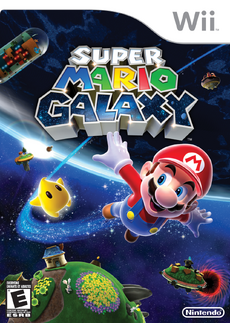
| ||||
| ||||
| Developer(s) | Nintendo EAD Tokyo | |||
| Publisher(s) | Nintendo | |||
| Director(s) | Yoshiaki Koizumi | |||
| Producer(s) | Shigeru Miyamoto Takao Shimizu | |||
| Composer(s) | Mahito Yokota Koji Kondo | |||
| Platform(s) | Wii | |||
| Genre(s) | 3D action-adventure platformer | |||
| Series | Super Mario | |||
| Predecessor | Super Mario Sunshine | |||
| Successor | Super Mario Galaxy 2 | |||
| Release Date(s) | JP: November 1, 2007 NA: November 12, 2007 | |||
| Mode(s) | Single-player Drop-in co-op multiplayer | |||
| Age Rating(s) | GameRankings: 97.64% Metacritic: 97/100 | |||
| Media Included | Wii Optical Disc | |||
| Available Input | Wii Remote and Nunchuk | |||
Super Mario Galaxy is the third 3D platforming game in the Super Mario series, published by Nintendo for the Wii in 2007. As demonstrated by the title, Galaxy includes elements of deep space travel, incorporating microgravity, interplanetary flight, and a predominantly orchestral soundtrack with synthesized sci-fi samples. Mario is granted the Star Spin ability, an attack and aerial course-correction move. Players can also point the Wii Remote at the television screen to collect and fire Star Bits. Most missions involve Mario traveling through a chain of themed planetoids via Launch Star, completing various objectives to earn a Power Star.
A sequel for the same console was released in 2010, titled Super Mario Galaxy 2.
Overview[]
Story[]
The plot of Super Mario Galaxy involves Mario saving Princess Peach—and the universe—from Bowser, whose master plan is to rebuild the universe in his own image, and rule over it with Peach at his side.
Bowser crashes the centennial Star Festival, using his fleet to lift Princess Peach's Castle from the ground. Kamek fires a blast of magic to knock Mario off of the castle's base.
Mario wakes up on a small planet. There he meets the Lumas and Rosalina, who watches over the cosmos. The Power Stars that powered their Comet Observatory have been stolen by Bowser, and Mario sets off to retrieve them.
As Mario collects Grand Stars, he can restore power to new Domes in the Observatory, unlocking access to new sets of galaxies. Mario also finds other characters from the Mushroom Kingdom that ended up lost in space.
With enough Power Stars, the Comet Observatory can fly to the center of the universe, allowing Mario to confront Bowser and save the galaxies. After a final boss battle, and the reunion of Mario and Peach, an artificial sun created by Bowser collapses into a supermassive black hole. The Lumas sacrifice themselves in an attempt to destroy it. Eventually, the universe collapses into a singularity and goes supernova.
Rosalina appears to Mario as a giantess in a void. She explains that the noise of a crying baby represents the rebirth of the stars, and that the new universe being created will not be entirely the same as the old one. Mario comes to in the Mushroom Kingdom alongside Peach, Bowser, and many minor characters from throughout the game. He looks to the skies and celebrates the new galaxy.
If the player has collected all 120 Power Stars, they will unlock the option to play as Luigi. The story restarts from his awakening on the small planet, and is otherwise unchanged except that Luigi takes Mario's place.
Gameplay[]

Mario in the Honeyhive Galaxy.
The gameplay of Super Mario Galaxy recontextualizes that of Super Mario 64 and Sunshine into a format where, instead of exploring sandbox-style worlds, Mario progresses through mostly linear series of planetoids. Mario's life meter has been reduced to three wedges, but the limit can temporarily be doubled to six using the Life Mushroom. Most enemies and hazards cause a consistent one unit of damage, but certain actions like being crushed by a Thwomp or falling into a black hole cause Mario to lose a life instantly.
Super Mario Galaxy heavily uses variable gravity mechanics, from the ablity to walk around spherical and cuboid planetoids, to platforming through two-dimensional sections with different gravity zones shown by arrows on the back wall. Gravity is the game's backbone and the inspiration for its space setting, though there are some galaxies with little focus on the mechanic.
Mario is controlled using the Wii Remote and its Nunchuk attachment. Shaking either controller causes Mario to perform the Star Spin, which can stun and defeat enemies, and gives Mario a slight second jump if used in midair. The Star Spin is also how the propulsion of Launch Stars is activated. There are also missions involving manta ray–surfing and ball rolling that use the motion control of the Wii Remote to control basic movement.
The Wii Remote is also aimed at the television screen to control the Star Cursor. It can collect and aim Star Bits, attract Mario towards Pull Stars, pull Sling Pods, and blow air to move certain bubbles when Mario is inside. Star Bits in particular are important as they can be fed to Hungry Lumas to unlock power-ups and bonus galaxies.
A second player can drop in for Co-Star Mode to control their own Star Cursor with a second Wii Remote. If the two players cooperate, they can collect and shoot Star Bits more efficiently, stun enemies, and perform the exclusive Co-Star Super Jump.
Fanon content[]
Category[]
- Fanon articles in the Super Mario Galaxy category should appear here automatically.
By name[]


